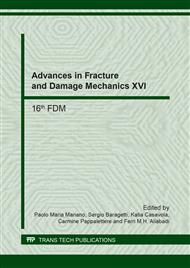[1]
F. Caputo, G. Lamanna, A. De Luca, R. Borrelli, S. Franchitti. Global-Local FE Simulation of a Plate LVI Test. Structural Durability & Health Monitoring – TechScience, 2013; 9(3): 253-267.
DOI: 10.32604/sdhm.2013.009.253
Google Scholar
[2]
R. Sepe, A. De Luca, G. Lamanna, F. Caputo. Numerical and experimental investigation of residual strength of a LVI damaged CFRP omega stiffened panel with a cut-out. Composites Part B: Engineering Journal, 2016; 102: 38-56.
DOI: 10.1016/j.compositesb.2016.07.009
Google Scholar
[3]
F. Caputo, A. De Luca, R. Sepe. Numerical Study of the Structural Behaviour of Impacted Composite Laminates Subjected to Compression Load. Composites Part B: Engineering Journal, 2015; 79: 456-465.
DOI: 10.1016/j.compositesb.2015.05.007
Google Scholar
[4]
F. Caputo, A. De Luca, G. Lamanna, R. Borrelli, U. Mercurio. Numerical Study for the Structural Analysis of Composite Laminates Subjected to Low Velocity Impact. Composite Part B: Engineering Journal, 2014; 67: 296-302.
DOI: 10.1016/j.compositesb.2014.07.011
Google Scholar
[5]
W. Van Paepegem, J. Degrieck. Tensile and Compressive Damage Coupling for fully-reversed bending fatigue of fibre-reinforced composites. Fatigue and Fracture of Engineering Materials & Structures, 2002; 25(6): 547-562.
DOI: 10.1046/j.1460-2695.2002.00496.x
Google Scholar
[6]
W. Van Paepegem, J. Degrieck. Fatigue damage modelling of fibre-reinforced composite materials. Review: Applied Mechanics Reviews, 2001; 54(4): 279-300.
DOI: 10.1115/1.1381395
Google Scholar
[7]
W. Van Paepegem, J. Degrieck. Experimental setup for and numerical modelling of bending fatigue experiments on plain woven glass/epoxy composites. Composite Structures, 2001; 51(1): 1-8.
DOI: 10.1016/s0263-8223(00)00092-1
Google Scholar
[8]
M.J. Salkind, Fatigue of composites. Corten, H.T. (ed. ) Composite Materials testing ad design (second conference). ASTM STP 497, Baltimore, American society for testing and materials, 1972: 143-169.
DOI: 10.1520/stp27745s
Google Scholar
[9]
H.T. Hahn, R.Y. Kim, Fatigue behaviour of composite laminates. Journal of composite materials, 1976; 10: 156-180.
Google Scholar
[10]
T.K. O'Brien, K.L. Reifsnider. Fatigue damage evaluation through stiffness measurements in boron-epoxy laminates. Journal of Composite Materials, 1981; 15: 55-70.
DOI: 10.1177/002199838101500105
Google Scholar
[11]
W. Hwang, K.S. Han, Cumulative damage models and multi-stress fatigue life prediction. Journal of Composite Materials, 1986; 20: 125-153.
DOI: 10.1177/002199838602000202
Google Scholar
[12]
Abaqus 6. 14: Analysis User's Manual.
Google Scholar


